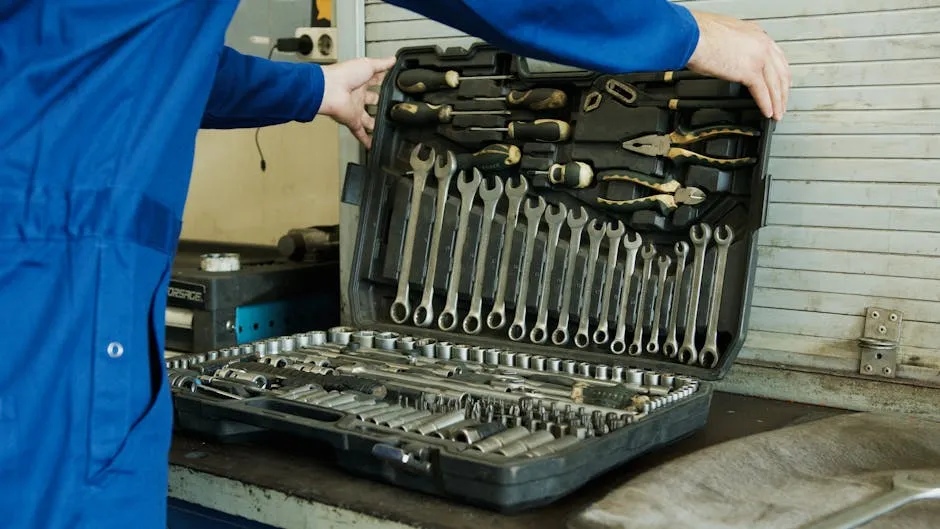

The Comprehensive Guide to Carbon Steel Tools: Properties, Uses, and Maintenance
Introduction
Carbon steel tools are vital in various industries. They offer excellent performance and durability. Notably, their versatility makes them suitable for many applications, from construction to culinary arts. Plus, they are cost-effective compared to other materials. This article will explore the properties, uses, and care of carbon steel tools.
Summary and Overview
Carbon steel is an alloy consisting primarily of iron and carbon. Its composition varies, leading to different types, including low, medium, and high-carbon steel. Historically, carbon steel tools have evolved significantly. From ancient civilizations to modern manufacturing, they’ve played a crucial role in craftsmanship. Today, carbon steel remains relevant due to its strength and adaptability in various applications.
In this article, we’ll cover essential aspects: understanding carbon steel, its properties, types of tools, manufacturing processes, and maintenance tips. This guide aims to equip you with valuable insights to make informed choices regarding carbon steel tools.

Understanding the importance of carbon steel tools can greatly enhance your decision-making when it comes to tool selection. carbon steel tools
Understanding Carbon Steel
What is Carbon Steel?
Carbon steel is primarily composed of iron and carbon. The carbon content typically ranges from 0.2% to 2%. This unique composition gives carbon steel its distinctive properties. Notably, it lacks significant alloying elements, which differentiates it from other steel types.
There are three main types of carbon steel: low-carbon, medium-carbon, and high-carbon steel. Low-carbon steel is malleable and often used for structural applications. Medium-carbon steel strikes a balance between strength and ductility, making it suitable for various tools. High-carbon steel, with its increased carbon content, offers exceptional hardness and wear resistance, ideal for cutting tools.
In manufacturing, around 50% of the steel produced globally is carbon steel, highlighting its importance. Whether in construction, automotive, or manufacturing sectors, carbon steel tools are essential for achieving reliable results.
Take a moment to evaluate the types of tools you currently use. Understanding their composition can help you choose the best tools for your needs.

Speaking of choosing the best tools, if you’re looking for something that slices through ingredients like a hot knife through butter, consider adding a Carbon Steel Chef’s Knife to your kitchen arsenal. It’s not just a knife; it’s a culinary game-changer!
Properties of Carbon Steel Tools
Key Features
When you think about carbon steel tools, consider their unique properties. Hardness is one of the most significant features. Measured on the Rockwell scale, hardness levels can vary widely. For instance, low-carbon steel typically scores between 50-60 HRC, while high-carbon steel can reach levels above 65 HRC.
Strength is another essential trait. Tools made from high-carbon steel excel under stress, making them ideal for demanding tasks. Wear resistance is equally crucial. Tools with higher carbon content resist abrasion better, ensuring they last longer in tough environments.
Now, let’s talk about ductility. This refers to how much a material can deform without breaking. High-carbon steel can become brittle if not treated correctly, which may lead to failure under heavy use. In contrast, medium-carbon options balance strength and ductility effectively.

When choosing tools, consider these properties carefully. They can significantly impact your work quality and efficiency.
If you’re serious about your woodworking projects, consider investing in a High Carbon Steel Chisel Set. These chisels hold an edge longer and make precision cuts, saving you time and frustration!
Types of Carbon Steel Tools
Overview of Common Tools
Carbon steel tools come in various forms, each with specific uses. Kitchen knives are among the most popular. They often feature high-carbon steel for exceptional sharpness and edge retention. This is why professional chefs prefer them; they slice through ingredients with ease.
Woodworking tools, like chisels and saws, also benefit from carbon steel. Their durability allows for precise cuts in hardwoods. High-carbon chisels hold an edge longer, reducing the need for frequent sharpening.
Industrial tools, such as drills and bits, rely on carbon steel for strength. In fact, the demand for carbon steel tools in manufacturing is on the rise, driven by their reliability and performance. As industries expand, the need for robust tools does too.
What’s your favorite carbon steel tool? Share it in the comments!

And for those pizza lovers out there, don’t forget to get yourself a Carbon Steel Pizza Cutter. Because let’s be real, who wants to struggle with a flimsy cutter when you could slice through your favorite pizza like a pro?
Specialized Applications
High-Carbon Steel Tools
High-carbon steel is an alloy with a carbon content between 0.6% and 1.5%. This high level of carbon provides unique properties, such as increased hardness and wear resistance. Tools made from high-carbon steel are ideal for tasks requiring sharp edges and durability.
The characteristics of high-carbon steel make it a top choice for manufacturing cutting tools. For example, kitchen knives, chisels, and saw blades often utilize this type of steel. Their ability to maintain sharpness over time makes them preferred options in both culinary and woodworking applications.

When comparing high-carbon steel to low and medium-carbon steel, the differences become evident. Low-carbon steel is more malleable but lacks the hardness required for sharp tools. Medium-carbon steel balances hardness and ductility but doesn’t achieve the same level of sharpness. Statistics show that high-carbon steel tools can reach hardness levels of 65 HRC or more, while low-carbon steel typically scores around 50-60 HRC.
For those requiring precision in their work, considering high-carbon options is essential. Whether you’re crafting a knife or undertaking detailed woodwork, high-carbon steel tools are worth exploring for your specific tasks.

Maintaining Carbon Steel Tools
Care and Maintenance Tips
Caring for carbon steel tools is essential for longevity. Proper maintenance can significantly extend their lifespan. Did you know that tools maintained well can last up to 50% longer? Here are some practical tips to keep your tools in top shape.
First, always clean and dry your tools after each use. Residue from materials can lead to rust. Use a soft cloth or sponge with warm, soapy water. Avoid abrasive pads that might scratch the surface. Once cleaned, dry your tools thoroughly to prevent moisture buildup.

Next, oil application is crucial. A thin layer of oil protects against rust. Use food-safe mineral oil for kitchen tools and any light machine oil for others. Apply the oil with a soft cloth, ensuring it covers all metal surfaces. This simple step can significantly enhance rust prevention.
Speaking of oil, if you’re looking for the best care for your tools, consider using Food Safe Mineral Oil. It’s perfect for keeping your kitchen tools rust-free and ready for action!
Storage also matters. Keep your carbon steel tools in a dry environment. Consider using a tool chest or a magnetic strip for easy access. Avoid damp areas like basements, as moisture can cause rust. If you can, store them in a climate-controlled area for the best results.
Caring for your tools ensures they perform well and last long. What maintenance routines do you follow? Share your tips in the comments!

FAQs
What is the difference between carbon steel and stainless steel?
Carbon steel and stainless steel serve different purposes. Carbon steel is primarily iron and carbon, making it strong and sharp. It’s often used in tools and knives. In contrast, stainless steel contains chromium, which prevents rust. This makes it ideal for kitchen appliances and utensils. Both have their applications, but if you need sharpness and edge retention, carbon steel is your best bet. Want to know more about a specific type?
How do I sharpen carbon steel tools?
Sharpening carbon steel tools is straightforward. Start with a whetstone or sharpening system. Use a coarse grit for repairing edges and a fine grit for honing. Always maintain a consistent angle—around 20 degrees works well for most tools. Don’t forget to clean the blade after sharpening to remove any metal filings. Regular maintenance keeps your tools in top shape. Have you tried sharpening your tools before?
Are carbon steel tools worth the investment?
Absolutely! Carbon steel tools are durable and perform exceptionally well. They can last years with proper care. Their ability to hold a sharp edge makes them ideal for precision tasks. While they may require more maintenance than stainless steel, the performance benefits often outweigh the extra effort. Investing in quality carbon steel tools pays off in the long run. Do you have a favorite tool that you’re considering upgrading?
How should I store my carbon steel tools?
Proper storage is key to preventing rust. Always keep your tools in a dry place. Consider using a toolbox or a magnetic strip for easy access. If possible, wrap them in a cloth or oil them lightly before storage. Avoid damp areas, as moisture can lead to rust. By taking these simple steps, you can significantly extend the life of your tools. What storage solutions have worked for you?
What are the best practices for maintaining carbon steel knives?
Caring for carbon steel knives involves a few simple steps. Always wash and dry your knife after use to prevent corrosion. Apply a thin layer of food-safe mineral oil for protection. Regularly sharpen your knife to maintain its edge. Store it in a safe place, ideally in a protective sleeve or on a magnetic strip. Following these practices will keep your knives sharp and ready for action. What tips do you use for knife maintenance?
Please let us know what you think about our content by leaving a comment down below!
Thank you for reading till here 🙂 And don’t forget to check out some handy High Carbon Steel Gardening Tools for all your green thumb needs!
All images from Pexels



